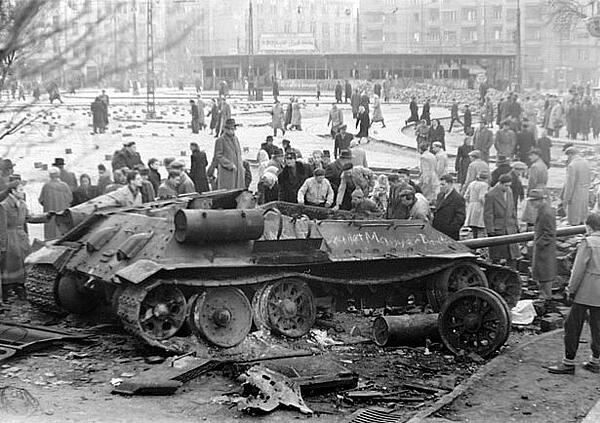The Hungarian Uprising of 1956
From 23 October to 10 November 1956, popular revolt against Soviet rule swept across Hungary. What started as a fervent student protest mushroomed into full-scale insurrection. A new government was set up which banned the notorious State Security Police (ÁVH). On 4 November, the USSR decided to quash the rebellion by force. Soviet tanks rolled and by 10 November, the revolution had been quelled.
From 1945 onward, Hungary was controlled by Moscow. Resources were siphoned from Hungary to Russia. Mátyás Rákosi, the leader of Hungary's Communist Party, was put in power by Stalin. Anybody who challenged the rule of Stalin and the USSR put their life in danger.
Stalin’s death in 1953 gave Eastern Europeans hope that they might be freed from Soviet rule. The more moderate Nikita Khrushchev took over from Stalin. In July 1956, the Soviet Politburo pressured Rákosi (nick-named ‘Stalin's Best Hungarian Disciple’) to resign. This resignation energized many Hungarians, particularly students, to push for more reforms. The situation was made more volatile by a bad harvest, fuel shortages, and a cold and west autumn.
On 22 October, the provocative ‘sixteen points’ list was compiled by students at the Technical University. Amongst other things, the list demanded the evacuation of all Soviet troops, elections by secret ballot, the right for workers to strike, and the trial of Mátyás Rákosi.

On 23 October 1956, 20,000 students and workers took to the streets of Budapest (the capital of Hungary) and gathered by the statue of József Bem, a Hungarian national hero. The writer Péter Veres spoke to the crowd, proclaiming the crowd’s wish for Hungary to be independent and democratic. The protesters later moved to the Parliament Building. By six in the evening, the crowd numbered 200,000. A statue of Stalin was torn down. The ÁVH, soldiers and protesters fought intermittently over the next few days.
The government collapsed. The reformist Imre Nagy was appointed prime minister; Janos Kadar became foreign minister. Cardinal Mindszenty, the most famous man to criticise the Soviets, was released from prison.
On 1 November 1956, Nagy announced by radio that Hungary would withdraw itself from the Warsaw Pact. This pushed the Russians too far. Kadar left the government in disgust and established a rival government in eastern Hungary which was supported by Soviet tanks. On 4 November Soviet forces arrived at Budapest and other parts of the country to restore order. The rebellion was brutally crushed. Tanks dragged round bodies through the streets of Budapest as a warning to others who were still protesting. By 10 November, the Soviets had regained control.
Around 2,000-3,000 Hungarians died in the brief rebellion, along with around 700 Russian soldiers. To escape Soviet reprisals, an estimated 200,000 Hungarians fled to the west in the wake of the uprising as refugees, leaving their homes and possessions in Hungary.
Nagy was tried and executed and buried in an unmarked grave. Kadar was put in charge. Soviet rule was re-established.
What of the West? President Dwight Eisenhower said:
"I feel with the Hungarian people."
J F Dulles, American Secretary of State, said:
"To all those suffering under communist slavery, let us say you can count on us."
But America and Western Europe went no further than offering moral support and condemning Russia. Why was this the case?
1) The geographic location of Hungary. Helping Hungary militarily could be tantamount to entering a new war. Both sides in the Cold War were nuclear powers and the risks were too great. Economic boycotts on the Soviet Union would be ineffective: Russia took what it needed from the countries it occupied.
2) The Suez Crisis. The West was distracted by the burgeoning crisis around the Suez Canal, which coincided with the Hungarian Uprising. On October 29 Israeli troops attacked the Egyptian Sinai. The Suez Crisis was considered important geopolitically to the West than the plight of the rebelling hungarians. Britain, France and America concentrated their resources on this crisis.
See also: Hungarian Secret Police
MLA Citation/Reference
"The Hungarian Uprising of 1956". HistoryLearning.com. 2026. Web.
